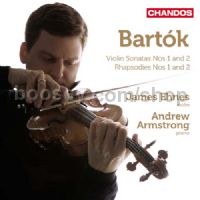Violin Sonatas (Chandos Audio CD)
Violin Sonatas (Chandos Audio CD)
* Estimated price converted from UK retail price
James Ehnes (violin), Andrew Armstrong (piano): Violin Sonata Nos 1&2/Rhapsody Nos 1&2/Andante
This is the second volume in a series devoted to the works for strings by Béla Bartók, with James Ehnes the featured soloist. Earlier this year, Ehnes recorded the Violin and Viola Concertos (CHAN 10690), which was made Disc of the Month in Gramophone magazine. On this new recording, he turns to the Violin Sonatas and Rhapsodies, complemented by the earliest surviving work by Bartók for violin and piano, an Andante. He is accompanied by the pianist Andrew Armstrong.
Dedicated to the Hungarian violinist Adila d’Arányi, the sonatas for violin and piano were composed in 1921 – 22, around the same time as the highly successful ballet score The Miraculous Mandarin. Of the two works, the Sonata in C sharp minor is the more traditional in terms of its structure, and characterised by a mood that is sometimes exhilarated, sometimes turbulent – but always virtuosic. The finale builds from a series of increasingly wild dances, folk-like in style but entirely expressionistic.
In the Sonata in C major, Bartók removes himself from classical form and traditional tonal practice, calling on the violinist to distance himself from the romantic manner of playing. At several points, for example, the violin is played without vibrato, producing an ethereally cool and distant sound. The improvisatory character is strong throughout, as the work repeatedly alternates between the quiet and thoughtful, and the stormy and strident. The ending, in contrast to the earlier sonata, is understated, emotional, and expressive.
Bartók’s two rhapsodies for piano and violin, dedicated respectively to Joseph Szigeti and Zoltán Székely, are steeped in the tradition of Hungarian folk music. Exuberant and infectious, the works are heavily inspired by the csárdás, the national dance of Hungary, and display the traditional pairing of lassú (slow) and friss (lively) movements.




